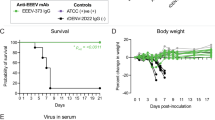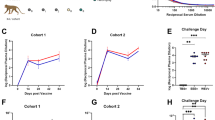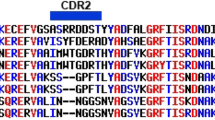Abstract
Eastern equine encephalitis virus (EEEV) is a mosquito-transmitted alphavirus with a high case mortality rate in humans. EEEV is a biodefence concern because of its potential for aerosol spread and the lack of existing countermeasures. Here, we identify a panel of 18 neutralizing murine monoclonal antibodies (mAbs) against the EEEV E2 glycoprotein, several of which have ‘elite’ activity with 50 and 99% effective inhibitory concentrations (EC50 and EC99) of less than 10 and 100 ng ml−1, respectively. Alanine-scanning mutagenesis and neutralization escape mapping analysis revealed epitopes for these mAbs in domains A or B of the E2 glycoprotein. A majority of the neutralizing mAbs blocked infection at a post-attachment stage, with several inhibiting viral membrane fusion. Administration of one dose of anti-EEEV mAb protected mice from lethal subcutaneous or aerosol challenge. These experiments define the mechanistic basis for neutralization by protective anti-EEEV mAbs and suggest a path forward for treatment and vaccine design.
This is a preview of subscription content, access via your institution
Access options
Access Nature and 54 other Nature Portfolio journals
Get Nature+, our best-value online-access subscription
$32.99 / 30 days
cancel any time
Subscribe to this journal
Receive 12 digital issues and online access to articles
$119.00 per year
only $9.92 per issue
Buy this article
- Purchase on SpringerLink
- Instant access to full article PDF
Prices may be subject to local taxes which are calculated during checkout





Similar content being viewed by others
Data availability
The authors declare that all data supporting the findings of this study are available within the paper and its Supplementary Information. The Supplementary Tables provide data on the newly generated mAbs and mutagenesis (alanine and arginine) mapping of the mAb binding sites on EEEV E2 protein.
References
Garlick, J. et al. Locally acquired eastern equine encephalitis virus disease, Arkansas, USA. Emerg. Infect. Dis. 22, 2216–2217 (2016).
Mukerji, S. S., Lam, A. D. & Wilson, M. R. Eastern equine encephalitis treated with intravenous immunoglobulins. Neurohospitalist 6, 29–31 (2016).
Armstrong, P. M. & Andreadis, T. G. Eastern equine encephalitis virus-old enemy, new threat. N. Engl. J. Med. 368, 1670–1673 (2013).
Eastern Equine Encephalitis (Centers for Disease Control and Prevention, 2018); https://www.cdc.gov/easternequineencephalitis/
Lindsey, N. P., Staples, J. E. & Fischer, M. Eastern equine encephalitis virus in the United States, 2003-2016. Am. J. Trop. Med. Hyg. 98, 1472–1477 (2018).
Tyler, K. L. Acute viral encephalitis. N. Engl. J. Med. 379, 557–566 (2018).
Tan, Y. et al. Large scale complete genome sequencing and phylodynamic analysis of eastern equine encephalitis virus reveal source-sink transmission dynamics in the United States. J. Virol. https://doi.org/10.1128/JVI.00074-18 (2018).
Hunt, A. R., Frederickson, S., Maruyama, T., Roehrig, J. T. & Blair, C. D. The first human epitope map of the alphaviral E1 and E2 proteins reveals a new E2 epitope with significant virus neutralizing activity. PLoS Negl. Trop. Dis. 4, e739 (2010).
Sherman, M. B. & Weaver, S. C. Structure of the recombinant alphavirus Western equine encephalitis virus revealed by cryoelectron microscopy. J. Virol. 84, 9775–9782 (2010).
Zhang, R. et al. 4.4 Å cryo-EM structure of an enveloped alphavirus Venezuelan equine encephalitis virus. EMBO J. 30, 3854–3863 (2011).
Voss, J. E. et al. Glycoprotein organization of Chikungunya virus particles revealed by X-ray crystallography. Nature 468, 709–712 (2010).
Li, L., Jose, J., Xiang, Y., Kuhn, R. J. & Rossmann, M. G. Structural changes of envelope proteins during alphavirus fusion. Nature 468, 705–708 (2010).
Smith, T. J. et al. Putative receptor binding sites on alphaviruses as visualized by cryoelectron microscopy. Proc. Natl Acad. Sci. USA 92, 10648–10652 (1995).
Zhao, J. et al. Phage display identifies an Eastern equine encephalitis virus glycoprotein E2-specific B cell epitope. Vet. Immunol. Immunopathol. 148, 364–368 (2012).
EnCheng, S. et al. Analysis of murine B-cell epitopes on Eastern equine encephalitis virus glycoprotein E2. Appl. Microbiol. Biotechnol. 97, 6359–6372 (2013).
Roehrig, J. T. et al. Identification of monoclonal antibodies capable of differentiating antigenic varieties of eastern equine encephalitis viruses. Am. J. Trop. Med. Hyg. 42, 394–398 (1990).
Pereboev, A. V., Razumov, I. A., Svyatchenko, V. A. & Loktev, V. B. Glycoproteins E2 of the Venezuelan and eastern equine encephalomyelitis viruses contain multiple cross-reactive epitopes. Arch. Virol. 141, 2191–2205 (1996).
Fox, J. M. et al. Broadly neutralizing alphavirus antibodies bind an epitope on E2 and inhibit entry and egress. Cell 163, 1095–1107 (2015).
Smith, S. A. et al. Isolation and characterization of broad and ultrapotent human monoclonal antibodies with therapeutic activity against Chikungunya virus. Cell Host Microbe 18, 86–95 (2015).
Hunt, A. R., Frederickson, S., Hinkel, C., Bowdish, K. S. & Roehrig, J. T. A humanized murine monoclonal antibody protects mice either before or after challenge with virulent Venezuelan equine encephalomyelitis virus. J. Gen. Virol. 87, 2467–2476 (2006).
Hülseweh, B. et al. Human-like antibodies neutralizing Western equine encephalitis virus. MAbs 6, 718–727 (2014).
Pal, P. et al. Development of a highly protective combination monoclonal antibody therapy against Chikungunya virus. PLoS Pathog. 9, e1003312 (2013).
Jin, J. et al. Neutralizing monoclonal antibodies block Chikungunya virus entry and release by targeting an epitope critical to viral pathogenesis. Cell Rep. 13, 2553–2564 (2015).
Zhang, R. et al. Mxra8 is a receptor for multiple arthritogenic alphaviruses. Nature 557, 570–574 (2018).
Schilte, C. et al. Cutting edge: independent roles for IRF-3 and IRF-7 in hematopoietic and nonhematopoietic cells during host response to Chikungunya infection. J. Immunol. 188, 2967–2971 (2012).
Armstrong, P. M., Prince, N. & Andreadis, T. G. Development of a multi-target TaqMan assay to detect eastern equine encephalitis virus variants in mosquitoes. Vector Borne Zoonotic Dis. 12, 872–876 (2012).
Gardner, C. L., Ebel, G. D., Ryman, K. D. & Klimstra, W. B. Heparan sulfate binding by natural eastern equine encephalitis viruses promotes neurovirulence. Proc. Natl Acad. Sci. USA 108, 16026–16031 (2011).
Edwards, J. & Brown, D. T. Sindbis virus-mediated cell fusion from without is a two-step event. J. Gen. Virol. 67, 377–380 (1986).
Fong, R. H. et al. Exposure of epitope residues on the outer face of the chikungunya virus envelope trimer determines antibody neutralizing efficacy. J. Virol. 88, 14364–14379 (2014).
Sun, C., Gardner, C. L., Watson, A. M., Ryman, K. D. & Klimstra, W. B. Stable, high-level expression of reporter proteins from improved alphavirus expression vectors to track replication and dissemination during encephalitic and arthritogenic disease. J. Virol. 88, 2035–2046 (2014).
Wust, C. J., Crombie, R. & Brown, A. Passive protection across subgroups of alphaviruses by hyperimmune non-cross-neutralizing anti-Sindbis serum. Proc. Soc. Exp. Biol. Med. 184, 56–63 (1987).
Roehrig, J. T., Hunt, A. R., Kinney, R. M. & Mathews, J. H. In vitro mechanisms of monoclonal antibody neutralization of alphaviruses. Virology 165, 66–73 (1988).
Flynn, D. C., Olmsted, R. A., Mackenzie, J. M.Jr.. & Johnston, R. E. Antibody-mediated activation of Sindbis virus. Virology 166, 82–90 (1988).
Haslwanter, D., Blaas, D., Heinz, F. X. & Stiasny, K. A novel mechanism of antibody-mediated enhancement of flavivirus infection. PLoS Pathog. 13, e1006643 (2017).
Agapov, E. V. et al. Localization of four antigenic sites involved in Venezuelan equine encephalomyelitis virus protection. Arch. Virol. 139, 173–181 (1994).
Pence, D. F., Davis, N. L. & Johnston, R. E. Antigenic and genetic characterization of Sindbis virus monoclonal antibody escape mutants which define a pathogenesis domain on glycoprotein E2. Virology 175, 41–49 (1990).
Vrati, S., Fernon, C. A., Dalgarno, L. & Weir, R. C. Location of a major antigenic site involved in Ross River virus neutralization. Virology 162, 346–353 (1988).
Porta, J. et al. Locking and blocking the viral landscape of an alphavirus with neutralizing antibodies. J. Virol. 88, 9616–9623 (2014).
Watson, A. M. et al. Ribbon scanning confocal for high-speed high-resolution volume imaging of brain. PLoS ONE 12, e0180486 (2017).
Charles, P. C., Walters, E., Margolis, F. & Johnston, R. E. Mechanism of neuroinvasion of Venezuelan equine encephalitis virus in the mouse. Virology 208, 662–671 (1995).
Honnold, S. P. et al. Eastern equine encephalitis virus in mice I: clinical course and outcome are dependent on route of exposure. Virol. J. 12, 152 (2015).
Honnold, S. P. et al. Eastern equine encephalitis virus in mice II: pathogenesis is dependent on route of exposure. Virol. J. 12, 154 (2015).
Pal, P. et al. Chikungunya viruses that escape monoclonal antibody therapy are clinically attenuated, stable, and not purified in mosquitoes. J. Virol. 88, 8213–8226 (2014).
Zhou, T. et al. Structural basis for broad and potent neutralization of HIV-1 by antibody VRC01. Science 329, 811–817 (2010).
Law, M. et al. Broadly neutralizing antibodies protect against hepatitis C virus quasispecies challenge. Nat. Med. 14, 25–27 (2008).
Julien, J. P., Lee, P. S. & Wilson, I. A. Structural insights into key sites of vulnerability on HIV-1 Env and influenza HA. Immunol. Rev. 250, 180–198 (2012).
Klimstra, W. B., Ryman, K. D. & Johnston, R. E. Adaptation of Sindbis virus to BHK cells selects for use of heparan sulfate as an attachment receptor. J. Virol. 72, 7357–7366 (1998).
Aguilar, P. V. et al. Structural and nonstructural protein genome regions of eastern equine encephalitis virus are determinants of interferon sensitivity and murine virulence. J. Virol. 82, 4920–4930 (2008).
Gardner, C. L. et al. Antibody preparations from human transchromosomic cows exhibit prophylactic and therapeutic efficacy against Venezuelan equine encephalitis virus. J. Virol. 2, e00226-17 (2017).
Acknowledgements
This work was supported by the Defense Threat Reduction Agency (grant no. HDTRA1-15-1-0013 to M.S.D. and W.B.K. and grant no. HDTRA1-13-1-0034 to J.E.C) and National Institutes of Health grant no. R01 AI095436 to W.B.K.
Author information
Authors and Affiliations
Contributions
A.S.K., S.K.A., A.Z., M.K.S., D.S.R., D.W.T., W.B.K. and M.S.D. designed the experiments. A.S.K., S.K.A., C.L.G., A.Z., D.W.T., C.S. and K.B. performed the experiments. A.S.K., S.K.A, C.L.G., D.H.F., A.Z., D.W.T. and K.B. performed the data analysis. L.E.W., J.E.C. and D.H.F. contributed key reagents. D.S.R. and D.H.F. contributed the methodology. A.S.K. and M.S.D. wrote the initial draft of the manuscript, with the other authors providing comments and edits to the final version.
Corresponding author
Ethics declarations
Competing interests
M.S.D. is a consultant for InBios International and is on the Scientific Advisory Board of Moderna. J.E.C. has served as a consultant for Takeda Vaccines, Sanofi Pasteur, Pfizer and Novavax, is on the Scientific Advisory Boards of CompuVax, GigaGen, Meissa Vaccines, PaxVax, and is the Founder of IDBiologics.
Additional information
Publisher’s note: Springer Nature remains neutral with regard to jurisdictional claims in published maps and institutional affiliations.
Supplementary information
Supplementary Information
Supplementary Figures 1–6.
Supplementary Table 1
Characteristics of anti-EEEV mAbs.
Supplementary Table 2
Relative binding of anti-EEEV mAbs to E2 alanine mutants.
Supplementary Table 3
Relative binding of anti-EEEV mAbs to E2 select arginine mutants.
Rights and permissions
About this article
Cite this article
Kim, A.S., Austin, S.K., Gardner, C.L. et al. Protective antibodies against Eastern equine encephalitis virus bind to epitopes in domains A and B of the E2 glycoprotein. Nat Microbiol 4, 187–197 (2019). https://doi.org/10.1038/s41564-018-0286-4
Received:
Accepted:
Published:
Issue date:
DOI: https://doi.org/10.1038/s41564-018-0286-4
This article is cited by
-
Three positively charged binding sites on the eastern equine encephalitis virus E2 glycoprotein coordinate heparan sulfate- and protein receptor-dependent infection
Nature Communications (2025)
-
Structural elucidation of a unique binding mode by an intact alphavirus human IgG molecule to a quaternary epitope
Nature Communications (2025)
-
The low-density lipoprotein receptor promotes infection of multiple encephalitic alphaviruses
Nature Communications (2024)
-
A molecular understanding of alphavirus entry and antibody protection
Nature Reviews Microbiology (2023)
-
Antibodies targeting epitopes on the cell-surface form of NS1 protect against Zika virus infection during pregnancy
Nature Communications (2020)



